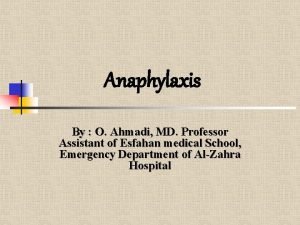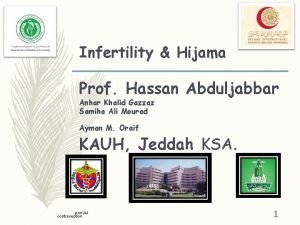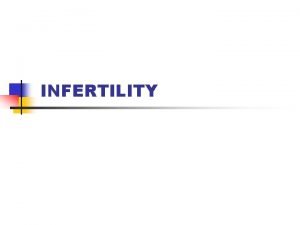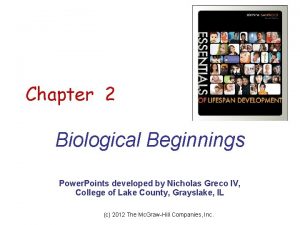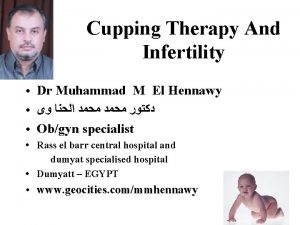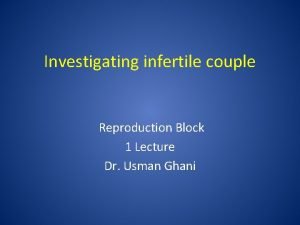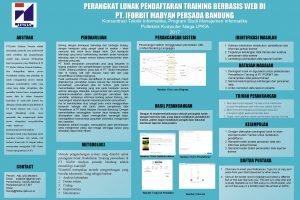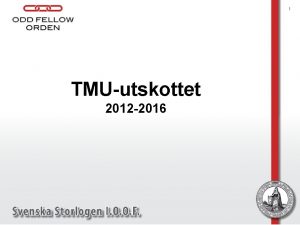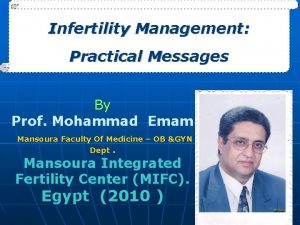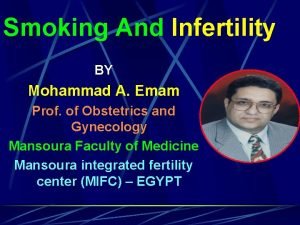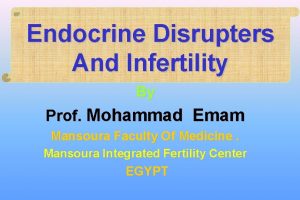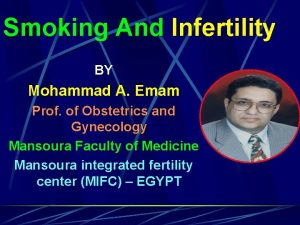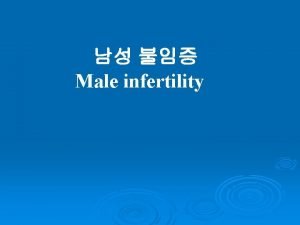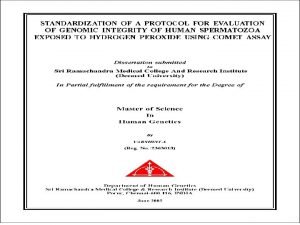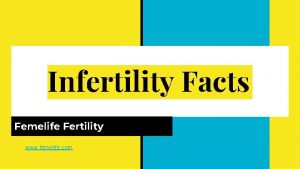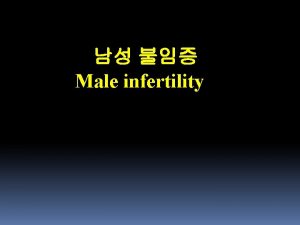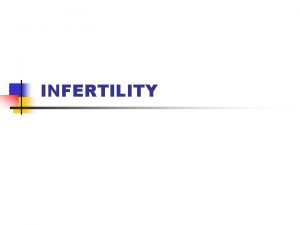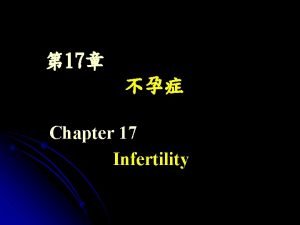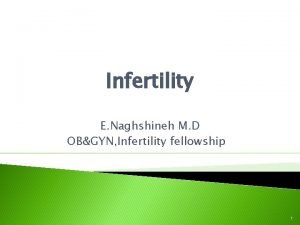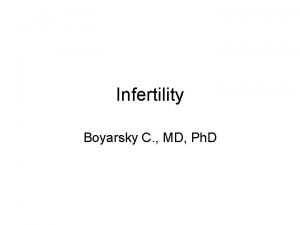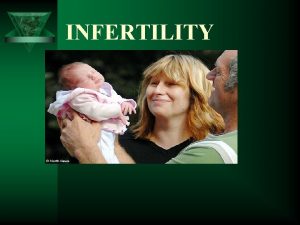Dr Maedeh Ahmadi Fellow in Infertility Emam Hospital




















- Slides: 20

Dr. Maedeh Ahmadi Fellow in Infertility Emam Hospital Tehran University of Medical Sciences

Utility of gonadotropin-releasing hormone agonists for fertility preservation in women receiving chemotherapy: pros and cons Copyright © 2020 American Society for Reproductive Medicine, Published by Elsevier Inc.

Con 1: Marie-Madeleine Dolmans, M. D. , Ph. D Chemotherapy-induced ovarian damage: apoptosis and/or in vitro activation? � ovarian reserve’’ is typically used to refer to the population of primordial follicles (PMFs). This population is very sensitive to cytotoxic drugs, especially alkylating agents (CPA). � creating DNA cross-links in replicating cells, which finally cause DNA breaks and ultimately trigger apoptosis. Granulosa cells of growing follicles are highly sensitive to toxic drugs, resulting in their apoptosis, as a major mechanism of many chemotherapy agents. � The loss of larger growing follicles is responsible for the significant decrease in AMH levels during chemotherapy.

� Chemotherapy drugs can also damage the ovary by inducing PMF activation, leading to the ‘‘burn-out’’ of the PMF. � We should bear in mind that chemotherapy drugs can also damage the ovarian stroma and vasculature, negatively impacting the ovarian reserve as well as the normal follicle development. � the last studies in human ovaries it is not always clear whether the loss of PMF is due to apoptosis (direct damage) and/or is a result of indirect loss due to accelerated activation

Pro 1: Zeev Blumenfeld, M. D. The End of Controversy � more than 3, 100 Gn. RH-a cotreated patients, demonstrating a significant decrease in the premature ovarian insufficiency (POI) rate in survivors of malignant/autoimmune diseases. � Gn. RHa cotreatment significantly decreased POI and increased the pregnancy rate (PR), with comparable survival. � menstrual cycles, gonadotropins, sex hormones, and even antral follicle count (AFC) and AMH are surrogate markers, the gold standard of fertility preservation is PR. � Gn. RH-a was also effective in stem cell transplantation (SCT) patients treated with aggressive chemotherapy.

� Gn. RH-a can effectively prevent chemotherapy associated menometrorrhagia. � Possible causes for contradictory reports are different ages, different timing of ovarian function assessment, and variable gonadotoxicity protocols. � Resumption of ovarian function may occur as late as 2 years after chemotherapy; therefore, early assessment at 6 months may underestimate the Gn. RH-a effect. � Gn. RH-a cotreatment should be offered in addition to cryopreservation of embryos, ova, and ovarian tissue

Con 2: Hugh S. Taylor, M. D. Role of gonadotropin-releasing hormone in fertility preservation: lack of biological plausibility � lack of biological plausibility: As PMFs are not recruited by gonadotropins, it is not biologically plausible that use of an agent to suppress gonadotropin production would have an impact on the PMF pool. � Gn. RH-a coadministration did not prevent chemotherapy-induced PMF DNA damage and cell death in a murine model. � it has been hypothesized that Gn. RH-a may still antagonize the cytotoxicity of chemotherapeutics through unknown mechanisms. If true, this effect would not be confined to the ovary and would likely also inhibit the activity of chemotherapy on cancers. Fortunately, Gn. RH-a does not appear to reduce the effectiveness of chemotherapy. There is no evidence that Gn. RH antagonists have a direct effect on PMFs.


� AMH can serve only as an indirect marker of ovarian reserve. Although AMH may give some reassurance of folliculogenesis, it cannot directly evaluate the number of PMFs in the ovarian reserve or accurately predict pregnancy. Furthermore, it does not account for the detrimental effects of DNA damage on the oocyte itself that may further limit fertility. � there is no biologically plausible theory that would justify administration of Gn. RH antagonists for the protection of the hormone-insensitive PMF. � The best way to protect the PMF from damage is to remove it from the exposure using assisted reproductive technology and oocyte retrieval or by surgical tissue removal for future transplantation

Pro 2: Matteo Lambertini, M. D. , Ph. D. Lessons from the systematic review of women with early breast cancer � Use of Gn. RH-a during chemotherapy was associated with a significant reduction (from 30. 9% to 14. 1%) in the rates of chemotherapy-induced POI. � gonadal-protective effect of Gn. RH-a administration was observed irrespectively : patients’ age at the time of treatment/ hormone receptor status/ type and duration of chemotherapy. � none of the randomized trials investigating the role of temporary ovarian suppression with Gn. RH-a during chemotherapy were designed or powered to observe differences in posttreatment pregnancies.

Two main lessons � FIRST : temporary ovarian suppression with Gn. RH-a during chemotherapy should now be considered a standard option for ovarian function preservation in premenopausal breast cancer. : � SECOND data on posttreatment pregnancies remain limited (especially among patients with hormone receptorpositive disease that are candidates to adjuvant endocrine therapy following chemotherapy), use of Gn. RH-a during cytotoxic treatment should not be considered a stand-alone fertility-preserving procedure alternative to cryopreservation options.

Con 3: Kenny A. Rodriguez-Wallberg, M. D. , Ph. D. Concerns about methodology and interpretation of the data presented in clinical trials and metaanalysesd � It is important to highlight that sound investigations of efficacious fertility preservation methods in women treated for cancer or autoimmune diseases are complicate. � As the proportion of women from the cohort who will wish to become pregnant or who will attempt pregnancy is unknown, the a priori population needed for such a study, using the most relevant fertility outcomes for the women in this setting, the livebirth rate, is likely not feasible. � only a minority, between 10% and 20% of women accessing fertility preservation, seek care after the completion of cancer treatment to attempt pregnancy. Hence, most women might not a tempt pregnancy in the future.

Pro 3: Michael von Wolff, M. D. For patients, the overall clinical effect is more important than the effect in specific diseases and the understanding of the molecular effects � GNRH-A developed for the purpose of suppressing the pituitaryovarian axis. Building on the hypothesis that a suppressed ovary is less susceptible to chemotherapy, Gn. RH-a were suggested and tested as a possible fertility protective agent. � After several years of controversy, the result is sufficiently well known: in breast cancer, Gn. RH-a reduce the risk of amenorrhea in the short term and in the long term and increase the chance of a later pregnancy.

Are the results of these studies enough to allow Gn. RH-a to be used as a fertility protective agent during gonadotoxic treatment for any tumor entities? because it must be assumed that a therapy that has a fertility-protective effect in breast cancer should also be effective for malignancies treated with other chemotherapy � ‘‘no’’ because we are no longer in the Middle Ages, and therefore any indication should be evidence based. � ‘‘yes’’

� The different effects of Gn. RH-a in breast cancer and Hodgkin lymphoma: different chemotherapy compositions, different gonadotoxicities, differences in ovarian function that are expressed as a lower ovarian reserve in Hodgkin lymphoma; the Hodgkin lymphoma study groups simply wrongly selected or too small. � the indication for Gn. RH-a as a fertilityprotective measure should be made generously, because there is evidence for a fertility-protective effect. � There are first concepts of a molecular mechanism of action; Gn. RH-a have hardly any side effects; Gn. RH-a effects such as the reduction of severe vaginal bleeding during chemotherapy.





Thank you vrhrc. tums. ac. ir
 Nader ahmadi
Nader ahmadi Matlab princeton
Matlab princeton Nooria ahmadi
Nooria ahmadi Nima ahmadi pour anari
Nima ahmadi pour anari Cupping points
Cupping points Sherman silber md
Sherman silber md Ashwaq urban dictionary
Ashwaq urban dictionary Cystic fibrosis male infertility
Cystic fibrosis male infertility Cupping for infertility
Cupping for infertility Female infertility
Female infertility Functions of hospital pharmacist
Functions of hospital pharmacist Welcome phones
Welcome phones Fellow lpkia
Fellow lpkia What is a technical fellow at microsoft
What is a technical fellow at microsoft Clarence filsfils
Clarence filsfils Ieee fellow program
Ieee fellow program Odd fellow orden
Odd fellow orden Policy statement mun
Policy statement mun Asme fellow nomination
Asme fellow nomination Poor little black fellow summary
Poor little black fellow summary Odd fellow medlemsregister
Odd fellow medlemsregister


